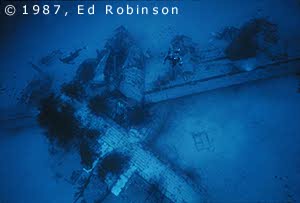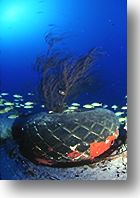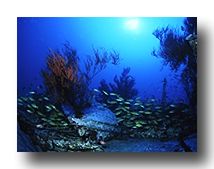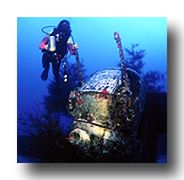PB4Y Navy Bomber
by Ed Robinson

Mayday! Mayday! Mayday! pierces the military airwaves on June 26, 1944 as the Navy PB4Y bomber prepares to ditch in the blue Hawaiian waters off Maui island.
The time is now January, 1987 and I am running Doug Niessen and a group of technical divers out of Maalaea Harbor in search of a four engine plane he has recently recorded while surveying the bottom terrain along the coast of Maui. The ghostly side-scan sonar image of four engines and connecting wings is unmistakably that of a plane. But so far the rest is a mystery since there is no local knowledge of any plane crash in this area.

Our search is hampered by gale winds buffeting my 21foot Boston Whaler as we track up and down a search pattern. Then bingo! as my depth recorder picks up obvious fish action over an otherwise desolate area. Our marker buoy signals the position as I attempt to maneuver my boat against the strong winds and drop the first dive team into the seething whitecaps.
Cheers of "Fantastic" and "Incredible" were the first sounds out of the mouths of the dive team as they clamored on board at the end of their dive. They reported the plane looked like a B24 bomber but through the veil of nitrogen narcoses and the twisted confusing orientation of the plane, positive identification could not be confirmed.

We now know through identification plates taken off one engine that the plane is a PB4Y-1 Navy bomber. Records indicate she was piloted by Lt. William Miller when she was ditched 6/26/44. No other information has been discovered about the wreckage.
The plane sits in just under 200 feet. The view is always the same as I descend down the anchor line. First a dark purple shadow begins to coalesce into a form of contrasting light and dark, and it seems to be moving! Is I descend closer the form becomes clearer as the wings and fuselage take shape. The movement becomes hundreds of reef fish: damsels, snapper, goatfish, surgeonfish, and often larger jacks and sharks.

The wreck looks confusing as if it were being viewed in a house of mirrors. The wings are upside down with the retracted landing gear facing the sun. How interesting, one of the large rubber tires is acting as a planter for a black coral tree. My mind seems to play tricks as I swim over the wings toward the tail; the plane is very short and as I round a bushy black coral forest I find the tail guns pointing into the sun, right side up!
And everywhere, everywhere there is life. It seems as if every black coral tree is home to at least one long-nose hawkfish. In fact every recess on the plane has some animal living in it. My eye catches movement near my hand and I jerk away quickly as a curious moray eel pokes its' head out of ribs inside a wing. As I stand on the bottom, looking across the wreckage I see a 3-dimensional scene of unending movement as the hundreds of fish I viewed on my descent are now milling close to the safety of their home.

The tail gun is always my favorite photo subject. My imagination engages in thoughts of what it must have been like to fight for your life at 10,000 feet when I see the sinister twin machinegun barrels aiming toward old enemies coming from above. The four silent engines are also good photo subjects with their bent props surrounded by swarms of fish, and bright red sponge covering their shrouds.
As I swim around the plane I see more photo opportunities than I have time to fulfill. At 200 feet (on air) I have limited myself to just ten minutes of bottom time, and sigh, it is time to ascend to my first decompression stop.
So, for a brief few minutes I have been blessed with a natural beauty and serenity that has come of a machine of war. Hay, here's a thought; maybe this is the best end for our weapons... guns to plows and ships and planes to reefs.
by Ed Robinson - 4/10/98edrob@maui.net
